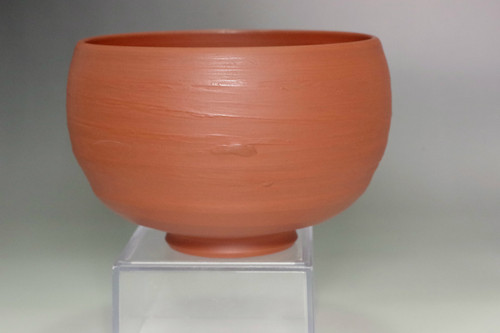Vintage Mumyoi pottery teabowl #5008
- SKU:
- 5008
- Shipping:
- Free Shipping
width: approx. 13cm (5 1/8in)
height: approx. 8.4cm (3 5/16in)
weight: 326g
note: Sado gold mine stamped on the underside.
condition: small damaged in bottom
This tea bowl is a fine piece of craftsmanship from Sado Island, a place rich in nature in the Sea of Japan. Its reddish hue comes from the clay of the once prosperous Sado Gold Mine, which supported Japan's economy during the Edo period by producing significant amounts of gold. Every time you hold this tea bowl, you will sense its profound history.
Because it is made with rare clay, this tea bowl holds value beyond that of mere tableware. It serves its purpose admirably both as a piece of fine art and as an everyday utensil. Fired from the clay created by the lush nature of Sado, this tea bowl is a special existence that allows you to feel the rich nature and history of Japan up close.
Mumyoi pottery
Mumyoi is a type of red soil which contains a rich amount of iron oxide which is produced from around the Gold Mine, and the Mumyoi pottery uses it as its pottery clay, which is then baked at high temperatures.
The character of the clay is such that it requires special work such as polishing while raw and then polishing it with sand after baking it.
In addition, the pottery clay goes through “elutriation” – a way to get rid of sand and impurities in the process of balancing the clay particles – using a 200-mesh sieve which makes the baked pottery clay shrink by around 30% due to the loss of these particles.
Therefore the product is extremely hard and when hit it makes a clear metallic sound and the more use it gets the more it shines.
The Mumyoi Ware products are gaining attention as a means of improving the taste of tea, alcohol, beer and coffee.
In China, Mumyoi had been used as a type of herbal medicine to cure hemostasis since ancient times, but as they did not know the source of the effect they seemingly named it Mumyoi (no name). In Japan this was gathered only around the Sado Gold Mine. It was a byproduct of mining operations during the 1640s – the height of the gold rush on Sado Island after the discovery of the Aikawa mines.
The history of Mumyoi ware began with Ito Jinpei creating Raku Ware using the Mumyoi produced from the Sado Mines in the 2nd year of Bunsei (1819).
Afterward, Miura Jozan (1836-1903) realized that Mumyoi produced from the Sado Mines has a very similar nature to Yixing clay. He doubled his efforts to change the usual Mumyoi ware, which was quite fragile, into strong pottery similar to the pottery created from the Yixing kiln in China, and he completed a piece of strong, high-temperature Mumyoi pottery. Tea tools in Mumyoi ware became popular among people who like green tea because they made tea delicious like Chinese Yixing ware.
According to a record, the famous shogunate retainer, Katsu Kaishu bought tea tools from Miura Jozan.
In 2003 Mumyoi Ware was registered as a National Important Intangible Cultural Property.
The Agency for Cultural Affairs is attempting to register Sado Aikawa gold mines in the World Heritage List now. Unfortunately, because of this, it became very difficult for potters to obtain Mumyoi from around Sado Aikawa gold mines because collecting the mine soil from the area was banned.















